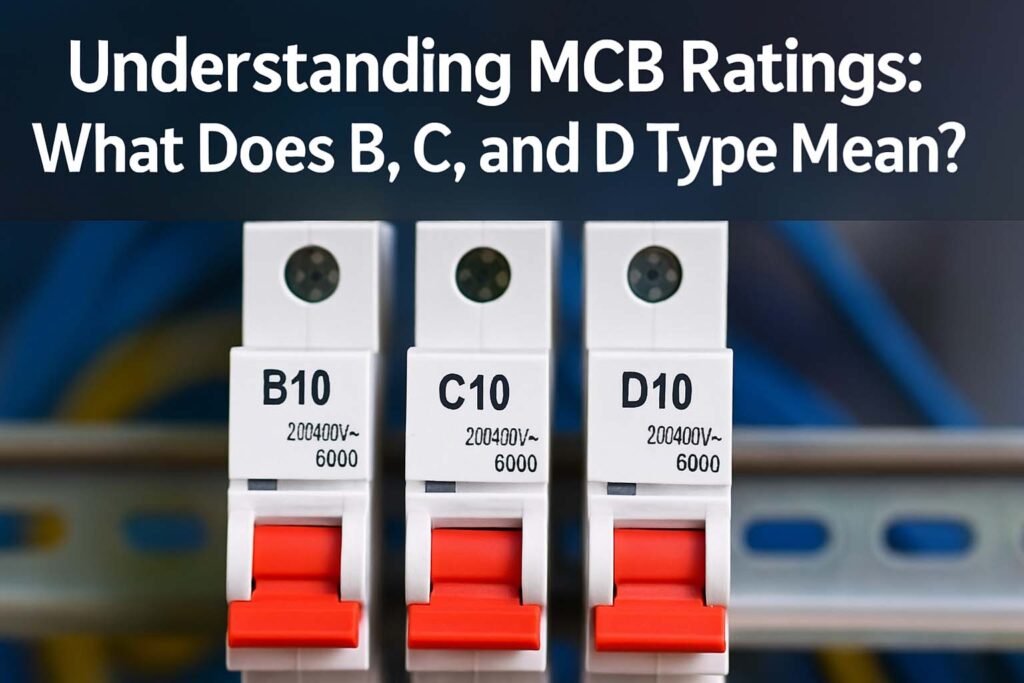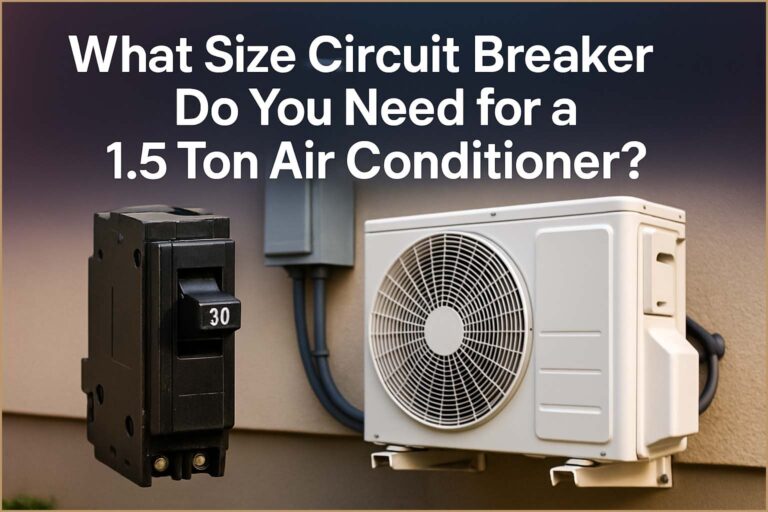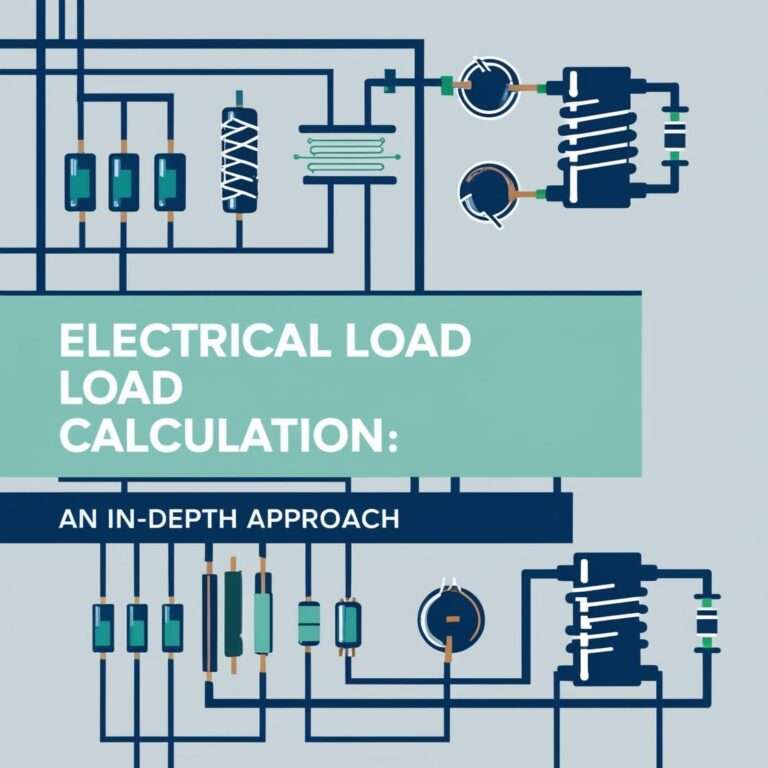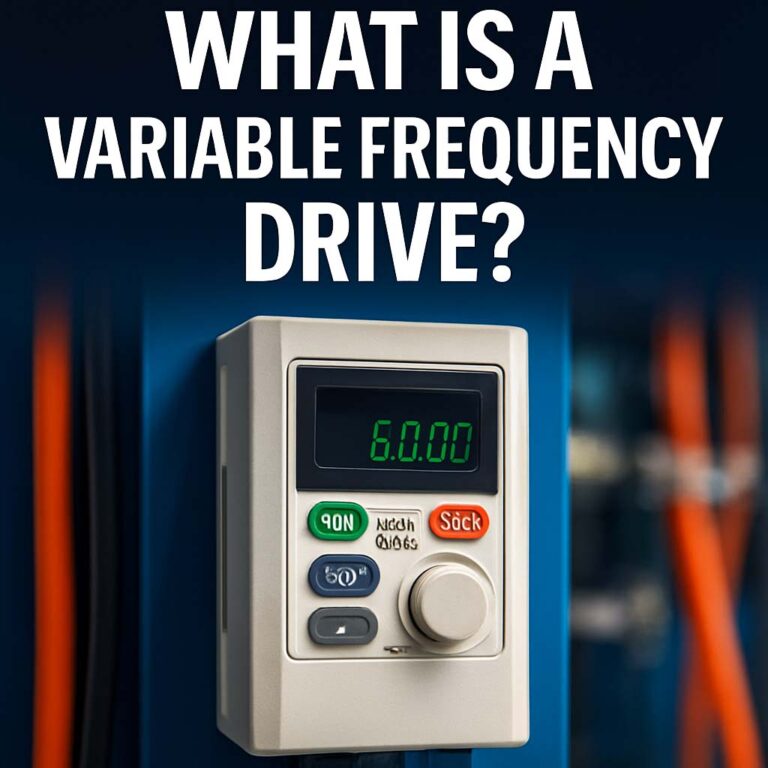Understanding MCB Ratings: What Does B, C, and D Type Mean?
Miniature Circuit Breakers (MCBs) are a vital part of modern electrical systems. They protect circuits from overloads and short circuits, helping prevent fire hazards and equipment damage. When choosing the right MCB for your home, office, or industrial setup, you’ll often come across ratings labeled as Type B, Type C, or Type D. These aren’t just letters — they define how the breaker behaves under fault conditions.
Table of Contents
Table of Contents

To avoid electrical failure or tripping issues, understanding these MCB ratings is essential. Whether you’re an electrician, homeowner, or student of electrical engineering, this guide will help you decode the mystery behind MCB types. We’ll discuss their meaning, applications, and the technical difference between them. You’ll also understand the comparison between Type B vs C breakers, and when to choose one over the other.
Key Takeaways:
- MCB rating includes both the current rating (in amps) and the trip curve (Type B, C, or D).
- Type B MCBs are best for domestic and light commercial use, while Type C and D are designed for more demanding environments.
- The main difference between Type B vs C breakers lies in their tripping response to inrush currents.
Use our online tool House Wiring Cable Size Calculator – Safe and Efficient Sizing for Home Circuits
What is MCB Rating and Why It Matters
An MCB rating generally has two components: the current rating and the tripping curve. The current rating tells you how much current the breaker can carry continuously — typically 6A, 10A, 16A, 32A, etc. But the tripping curve (denoted by B, C, or D) indicates how the breaker responds to short circuit or inrush current.
This matters because not all devices behave the same when powered on. Some have a large startup current (like motors), while others have a steady load (like lights). Choosing the wrong MCB can lead to unnecessary tripping or, worse, unsafe conditions.
Understanding Type B MCBs
Type B MCBs trip when the current exceeds 3 to 5 times the rated current. They are the most sensitive to surges and are suitable for:
- Residential wiring
- Lighting circuits
- General-purpose sockets
- Small appliances
For example, a 10A Type B MCB will trip instantly at a fault current of 30A to 50A. That makes it ideal for circuits where no high inrush currents are expected.
These MCBs help prevent nuisance tripping in home environments. If you’re not running large equipment or motors, a Type B breaker is usually sufficient. It’s also the most commonly installed MCB in domestic distribution boards.
Know more about Transformer Protection Schemes: Types and Application Guide
What is a Type C MCB?
Type C MCBs trip at 5 to 10 times the rated current. This makes them less sensitive to short-term surges and ideal for:
- Commercial applications
- Small workshops
- Fluorescent lighting with electronic ballast
- Devices with moderate inrush current like air conditioners, pumps, and microwaves
For a 10A Type C MCB, the breaker will trip at 50A to 100A. These breakers can tolerate short bursts of high current, which are common in inductive loads.
Electricians often choose Type C breakers for mixed-use circuits where a variety of loads are connected. They offer a good balance between protection and reliability in small-scale industrial and commercial environments.
Type D MCBs and Their Role
Type D MCBs trip at 10 to 20 times the rated current. These are specialized for high inrush current loads such as:
- Heavy motors
- Transformers
- X-ray machines
- Large compressors
A 10A Type D breaker trips only if the current exceeds 100A to 200A. This delay ensures that momentary spikes during startup don’t cause false trips.
Type D MCBs are mostly used in industrial applications. They’re not suitable for home circuits because they may not trip fast enough in domestic fault scenarios, posing a safety risk.
Know more about What Causes a Motor to Overload?
Type B vs C Breaker: What’s the Real Difference?
Let’s dive into the comparison of Type B vs C breakers — one of the most common queries in electrical design.
| Feature | Type B MCB | Type C MCB |
|---|---|---|
| Tripping Range | 3–5 × rated current | 5–10 × rated current |
| Application | Domestic circuits | Commercial/light industrial |
| Sensitivity | High | Moderate |
| Suitable for | Lights, sockets, small appliances | Motors, fans, small machines |
| Nuisance Tripping | More likely with inductive loads | Less likely |
| Cost | Lower | Slightly higher |
Type B vs C is mainly about the nature of the load. If you’re dealing with resistive loads, B is fine. But for circuits with fans, pumps, or devices that draw a short burst of high current at startup, C is better.
Know more about IEC Standard for Air Circuit Breaker
How MCB Trip Curve Works
The trip curve refers to how fast an MCB disconnects the power based on the level of overcurrent. Here’s how each type behaves:
- Type B Curve: Trips fast at lower overloads.
- Type C Curve: Allows moderate overcurrent for a short time.
- Type D Curve: Allows high overcurrent for longer durations.
This behavior is plotted as a time-current curve in engineering manuals. But in simpler terms, Type B is quick to act, while Type D is more tolerant of spikes.
Choosing the Right MCB Rating for Your Circuit
When selecting an MCB, consider:
- The type of load (resistive, inductive)
- The inrush current expected at startup
- Circuit wiring size and length
- Installation environment (residential, commercial, or industrial)
Also, ensure the MCB current rating aligns with the conductor size to avoid overheating or breaker malfunction. For instance, a 2.5mm² copper cable can safely carry around 20A, so a 16A MCB would be appropriate.
Always prioritize safety. If unsure, a certified electrician should assess the system.
Know more about What Type of Backup Protection is Used for an Alternator?
Common Mistakes When Choosing MCBs
- Using Type B for Motor Loads: This often causes nuisance tripping.
- Overrating MCBs: Leads to overheating and potential fire risk.
- Ignoring inrush current: Especially in HVAC, UPS, or motor circuits.
- Mixing types without load study: Can result in imbalance and poor selectivity.
When to Upgrade from Type B to C or D
If you’ve installed Type B breakers and they trip frequently without a fault, it’s time to review the load profile. Devices like air conditioners, refrigerators, and washing machines often draw higher startup current.
Switching from Type B to Type C can solve nuisance tripping in these cases. However, this should only be done after confirming the wire size and fault current protection still comply with standards.
Type D MCBs should only be used where it’s certain that the short circuit current will be sufficient to trip the breaker within safe limits.
MCB Rating vs Fuse: Which is Better?
Unlike a fuse, an MCB doesn’t need replacement after it trips. It simply resets. Moreover, MCBs provide a more accurate and reliable tripping mechanism. Their ratings are standardized under IEC 60898 or IEC 60947, depending on the application.
For domestic purposes, an MCB with an appropriate type rating provides safer and more convenient protection than a fuse.
Conclusion: Know Your MCB Before You Buy
Selecting the right MCB is more than just choosing a current rating. You must understand the type — B, C, or D — and match it to your circuit’s behavior.
If you’re wondering about Type B vs C breakers, just remember: Type B is for basic household needs, while Type C suits moderate machinery or mixed load setups. Type D is strictly for heavy industrial loads.
Choosing the correct MCB rating ensures safety, avoids unnecessary tripping, and extends the life of your electrical installation.
By understanding these ratings, you can design better, safer, and more efficient circuits — whether for a simple lighting panel or an entire factory floor.
Follow Us on Social:
Subscribe our Newsletter on Electrical Insights to get the latest updates in Electrical Engineering.
#MCBRating, #TypeBvsCBreaker, #ElectricalSafety, #CircuitBreakerTypes, #MCBExplained, #HomeElectrical, #ElectricalProtection, #MiniatureCircuitBreaker, #TypeDMCB, #TypeCMCB, #TypeBMCB, #ElectricalEngineering, #PowerDistribution, #MCBTutorial, #CircuitProtection






